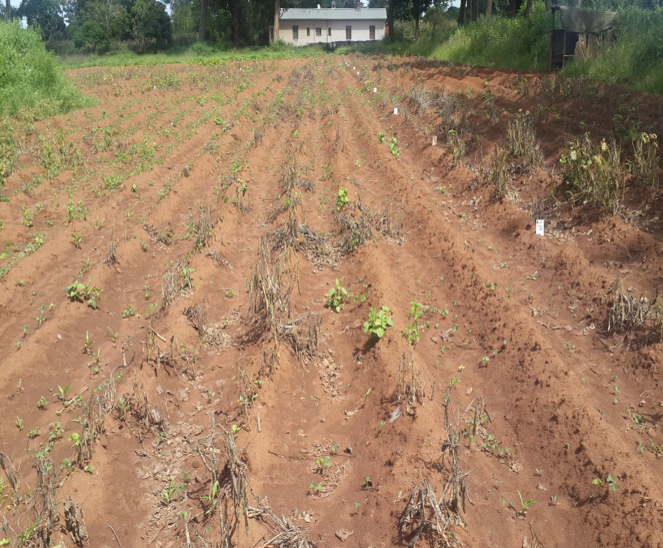The rainfall distribution for the 2015-16 Malawi crop growing season was in general below normal in many parts of the country. Drought conditions prevailed in many areas and crop yields were adversely affected including maize, the staple food for the country. The figure below shows rainfall distribution at the Salima site.
A subset of 10 Andean Diversity Panel (ADP) and 13 Durango Diversity Panel (DDP) lines that had been selected for good performance under biotic and abiotic stresses across Malawi, Tanzania, South Africa, Puerto Rico and the United States were planted at Bunda, Bvumbwe, MUST, and Chitala. The materials were grown in 4 row plots with three replications at each location. Phenological, yield and yield component data were determined.
The PIC population selections were planted at the same four sites (Bunda, Bvumbwe, MUST and Chitala). There were 282 lines planted as single row plots that were replicated three times. Plants were selected based on agronomic performance and tolerance to biotic and abiotic stresses in the field at the pod-filling stage, followed by seed type at harvest.
The National Bean Yield Trials (NBYT) comprised materials from the Bean/Cowpea CRSP project conducted from 2004 to 2007. The seed types range from small- to large-seeded and from solid to mottled seed colors. The lines are a mix of Andean and Mesoamerican lines and a variety of seed types including black, small red, carioca, brown, sugar cranberry, large red and red mottled.
Performance of bean trials
Drought had a profound effect on the trial performance resulting in loss of some trials at Bunda and MUST. The trials at Chitala were also drastically affected by drought and root rot. Bean common mosaic virus was prominent at Bunda and black-root reaction was observed in ABYT and ADP/DDP trials which contributed to poor stand apart from the drought that was experienced. PIC lines and the NBYT performed better in the second planting. Charcoal rot, caused by Macrophomina phaseolina, was the major disease at Bvumbwe in addition to drought stress, and the worst affected was the ADP/DDP trial (photo below).
PIC selections were made mainly at Bunda and Bvumbwe but a few were also included from Chitala. Selections at Bunda and Bvumbwe were based on pod load and seed type. In Chitala, all plants that survived the drought and produced seed were picked. Out of 282 lines derived from single plant selections done in 2014/2015 cropping season, 82 lines (29%) were selected and sent to South Africa for seed multiplication and advance.
The results of NBYT at Bunda showed highly significant differences in yield. Lines PC543-C3 and DG 2 were the earliest to achieve full flowering while the lines F11 MDRB (B) 25 and F11 MDRB (B) 24 were the first to reach physiological maturity. The highest yield was observed for the Kalima variety (2,858 kg/ha) followed by UCD 0234 (2,444 kg/ha). The overall mean yield was 1,771 kg/ha.
The NBYT results from the Bvumbwe Research Station showed highly significant statistical differences between the entries for days to flowering, days to maturity and 100 seed weight. There was no statistical significance in terms of grain yield among entries indicating similar yield performance. The earliest line to achieve physiological maturity was F12MDRB (A) 18 after 79 days. The top yielding line was F11MDRB (B) 24 (photo below) with 1,509 kg/ha followed by F3 MDRB (A) 8 with 1,378 kg/ha and UCD0234 with 1,365 kg/ha. The overall mean yield was 956 kg/ha.
The 2015/2016 crop growing season was challenging for crop growth and production. This was mainly due to drought. Trials from two of the sites, MUST and Chitala Research Station, were drastically affected and no data was collected. Two of the trials at Bunda, ADP/DDP and ABYT, recorded poor stands and this affected yield performance. Two trials, NBYT and PIC, had to be replanted at Bunda. Therefore, it is recommended that the ADP/DDP and NBYT be repeated in the 2016/2017 growing season. The PIC line selections sent to South Africa should be evaluated at multiple sites in order to determine their adaptation and to select outstanding entries for preliminary yield trials. Three lines from the NBYT, F11 MDRB (B) 24, DC 96-69 and DG 226, are being considered for release.



